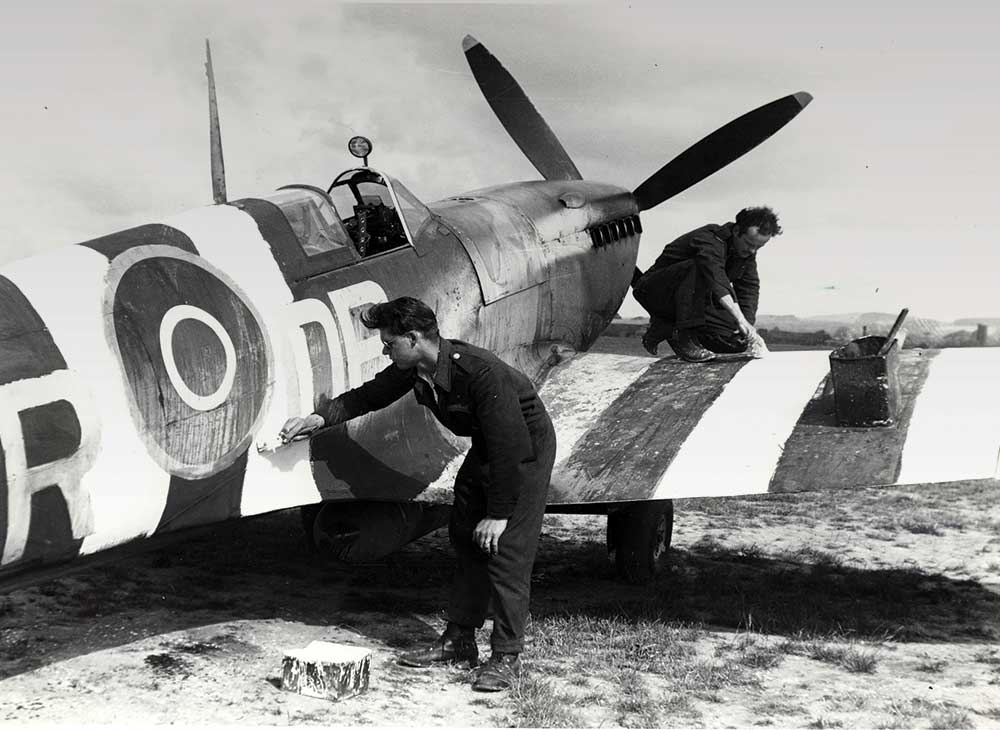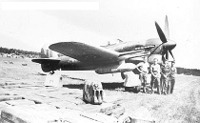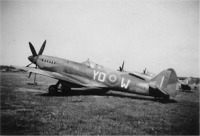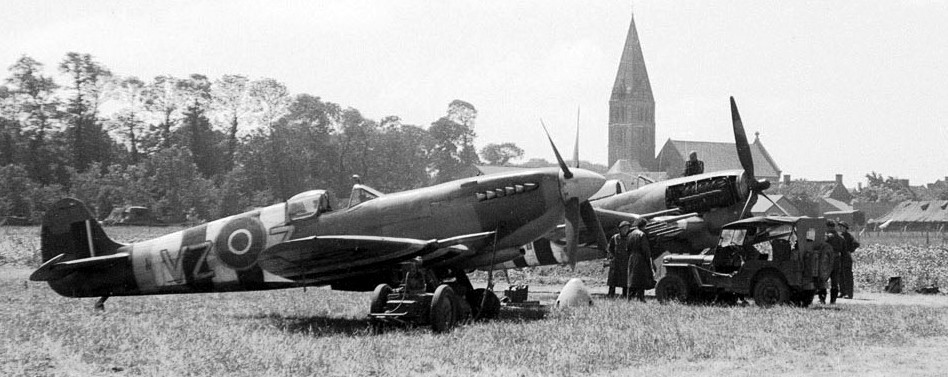

Every Royal Canadian Air Force squadron based in the United Kingdom was involved in supporting Operation Neptune / Overlord. The RCAF was involved for several months in bombing key enemy targets in the invasion area: roads, bridges, railways, airfields, and command and communications centres. Before H-Hour on D-Day, RCAF Lancasters of No. 6 Bomber Group dropped thousands of tons of bombs on German coastal defences.

Leading Aircraftman Stan Rivers (on the wing) and Ken Allenby of 402 Squadron, paint D-Day markings on aircraft. PL-30827, DND Archives
There were many Canadian pilots in the RAF, but all RCAF fighter squadrons were assigned to 83 Group which worked closely with the Anglo-Canadian invasion forces. A day-fighter wing consisted of three squadrons of 18 aircraft, 39 officers and 743 other ranks. RCAF squadrons in 83 Group were assigned to the 126, 127, 143 and 144 Canadian fighter wings. The 143 wing flew the Typhoon IB fighter-bomber while the other three flew the Spitfire IXB. The Typhoons could carry two 500 lb or 1,000 lb bombs to provide direct support to the ground forces.

Hawker Typhoon - 438 squadron
Canadian fighter pilots fought the Luftwaffe and helped achieve Allied air superiority over the bridgehead. Fighter squadrons escorted invading troops and attacked German ground positions. Later, as ground forces forged ahead, air superiority was easily maintained over an area that now reached some 100 km behind enemy lines. Allied ground forces could then move freely while German troops, whether they used roads or railways, or moved across fields could not do so without being targeted by RAF and RCAF fighters.

Spitfire - 401 squadron
Canadian and British squadrons demonstrated the meaning of air superiority to the soldiers fighting through the Atlantic Wall. When more than a dozen Ju 88s tried to break through to bomb the beaches, pilots of 401 Ram Squadron destroyed six and forced the remainder to flee.
No. 438 Squadron was assigned the task of dive bombing two concrete block houses overlooking the beach on which the 50th British Division was to land tanks. This operation had to be performed just as the tanks landing craft lowered their ramps.
The first Allied planes to operate from French soil since 1940, RCAF squadrons No. 441, 442, and 443 continued to ravage enemy columns and support offensives throughout the Normandy campaign, helping to tilt the tactical balance in the Allies' favour.

Supermarine Spitfire LF Mk. IXE, 412 Squadron RCAF, at Field Base B4 near Bény-sur-Mer, shortly after D-Day. (PL 30268. DND Archives)
Bomber Command - RCAF
In March 1944, Bomber Command began heavy strikes against rail communications in France, German coastal defences and German supply depots in preparation for the D-Day invasion. Bomber Command’s 83 squadrons operated from their airfields in eastern England, flying over enemy territory night after night. Fourteen of these squadrons were Canadian.
On D-Day, the airmen of Bomber Command flew two sorties: the first on the night of June 5-6 and the second the following night. The night before the invasion, Bomber Command put on a maximum effort, dispatching over 1,000 aircraft to attack coastal batteries at Fontenay, Houlgate, La Pernelle, Longues, Maisy, Merville, Mont Fleury, Ponte-du-Hoc, Quisterham and St. Martin-de-Varreville. The bombers included 551 Lancasters, 412 Halifaxes and 49 Mosquitos aircraft.
The Canadian squadrons were out in force. Lancaster bombers from 408 and 419 Squadrons departed in the dark from their fields at Linton-on-Ouse and Middleton St. George. They were soon joined by Halifax aircraft from 420 and 434 Squadrons at Tholthorpe; 424 and 433 at Skipton-on-Swale; 427 and 429 at Leeming; and 425, 426, 428, 431 and 432 from Dishforth, Linton-on-Ouse, Middleton St. George, Croft and East Moor respectively. The RCAF’s only Pathfinder unit, 405 Squadron, had already departed enroute to making the evening’s targets in Normandy.
The Germans were caught by surprise and there was an almost complete absence of German night-fighters. However, only two of the targets were free of cloud. This meant that most of the aircraft dropped their bombs on a navigation fix. An unprecedented 4,500 metric tonnes of bombs were dropped on the German positions—the greatest tonnage in a single night to that point in the war. Although not all of the guns were destroyed, the overall mission was judged as successful with only three aircraft lost.
Royal Canadian Air Force Squadrons
2nd Tactical Airforce - 83 Group
- 126 Wing - 401, 411, 412 Squadrons
- 127 Wing - 403, 416, 421 Squadrons
- 144 Wing - 441, 442, 443 Squadrons
- 143 Wing - 438, 439, 440 Squadrons
- 39(R) Wing - 414, 430 Squadrons
2nd Tactical Airforce - 85 Group
- 409, 410 Squadrons
Fighter Command - 10 Group
- 406 Squadron
Fighter Command - 11 Group
- 402, 418 Squadrons
Bomber Command - 6 (RCAF) Group
- 408, 419, 420, 424, 425, 426, 427, 428, 429, 431, 432, 433, 434 Squadrons
Bomber Command - 8 (P.F.F.) Group
- 405 Squadron
Coastal Command
- 423, 415, 404, 407 Squadrons
